Life-as-Activity: The Weave-the-Life Framework (v2.0)

A new member of the Life-as-Activity Approach
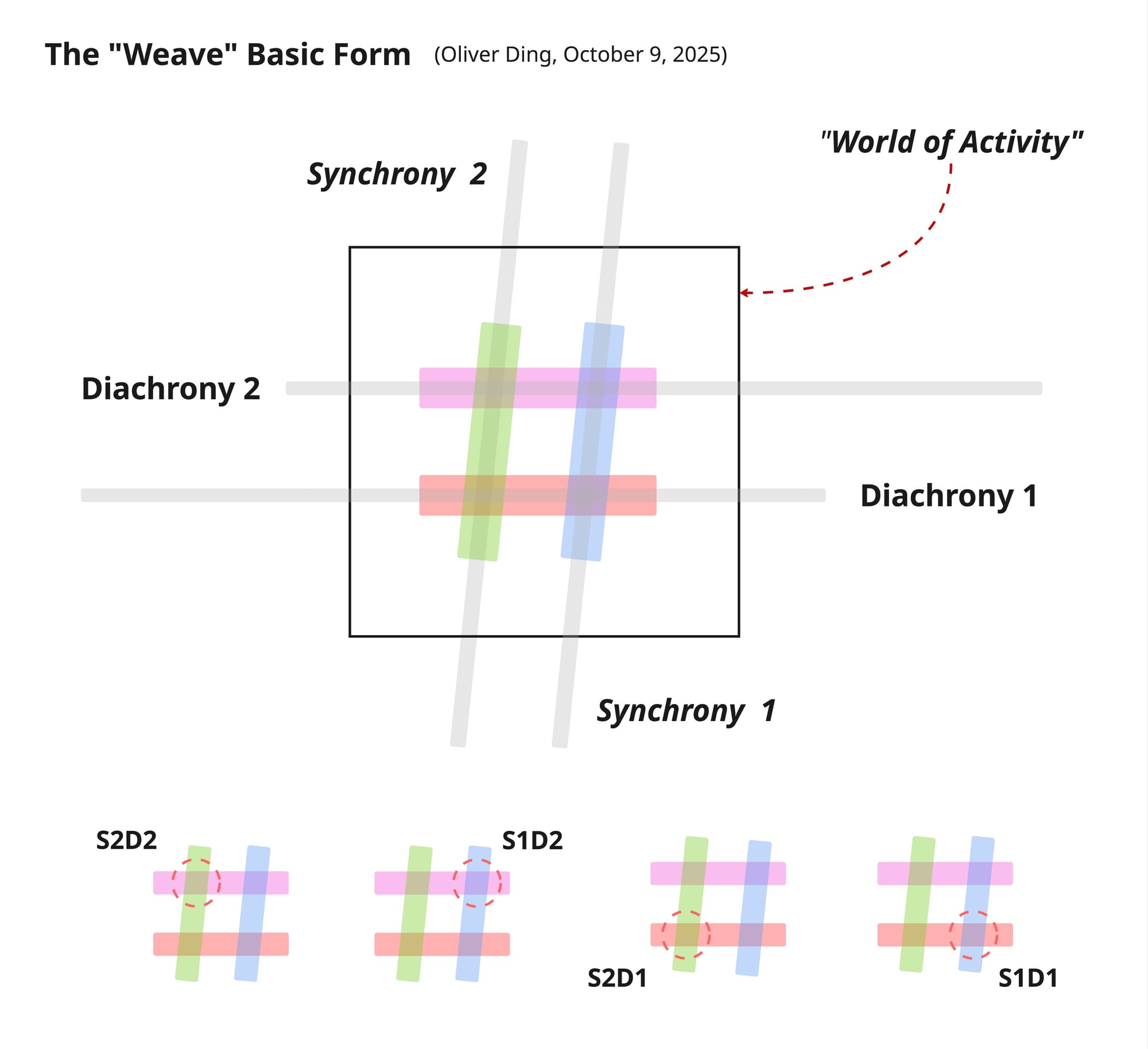
A few days ago, I introduced the “Weave” Basic Form as a meta-framework (see the diagram above).
This is a super-simple diagram that frames the activity within the World of Activity as the synthesis of two diachronical dimensions and two synchronical dimensions. The model consists of four Weave-points (S1D1, S1D2, S2D1, S2D2), each representing a structural nexus where one synchrony dimension intersects with one diachrony dimension.
As an abstract model, the “Weave” basic form serves as the foundation for generating derived forms and situational frameworks. More details can be found in [Meta-framework] The “Weave” Basic Form.
During the development of the Weave Basic Form, I experimented with several cases that incorporated activity-inspired principles as key elements. Later, I used the basic form to systematically design the Weave-the-Life framework, which includes a series of diagrams.
This article presents the complete Weave-the-Life Framework as a new addition to the Life-as-Activity Approach.
The Initial Idea: The Weave-the-Life Model
Inspired by the early experiments with the Weave Diagram, I developed the Weave-the-Life Model on October 3, 2025 (see diagram below).

This new model is similar to the original Create-Curate-Weave schema, but it employs four general terms: Activity, Opportunity, Enterprise, and Self.
While the Create-Curate-Weave schema was created as part of the World of Activity toolkit — a sub-framework of Creative Life Theory (v3.0) — the Weave-the-Life model was developed as a sub-framework of the Life-as-Activity approach, itself inspired by Activity Theory.
On the same day, I updated the landscape of the Life-as-Activity approach, incorporating the new model as a member of the approach (see diagram above).

The diagram presents a landscape of the Life-as-Activity approach, encompassing nine knowledge frameworks, eleven book drafts, and one tool.
The first three frameworks provide an ontological-level explanation that frames the entire approach.
- The Activity as Project Engagement model offers a theoretical integration that connects Andy Blunden’s approach with Yrjö Engeström’s Activity System Model.
- The Life-History Topology model proposes a way to understand social life, serving as the foundation for individual life development.
- The Weave-the-Life framework bridges Activity as Project Engagement and Life-History Topology, explaining how the former unfolds into the latter.
The other six frameworks function as an epistemological-level toolkit, each approaching a different unit of analysis with a distinct model.
Serving as the intermediate layer between the Activity as Project Engagement model and the Life-History Topology model, the Weave-the-Life model plays a significant role in the approach. Although it is the newest member of the Life-as-Activity approach, it marks an important milestone because it contributes to the micro–meso–macro connection.

The Weave-the-Life model weaves together four dimensions: Activity, Enterprise, Life, and Opportunity. Activity refers to individual engagement in projects. Enterprise represents the crystallization of collaborative action—it develops its own logic and trajectory beyond individual intentions. Life (in the narrow sense) refers to individual life course. Opportunity serves as the channel through which social structures and historical events enter individual experience. These four dimensions are continuously interwoven in lived experience, creating the fabric of both individual biography and social reality.
The framework operates bidirectionally. In the forward direction, individual projects crystallize into enterprises that transcend personal will. In the reverse direction, social structures and historical events enter individual life through enterprises and opportunities. This bidirectional dynamic helps us understand both individual agency and structural constraint. It shows how otherness—those aspects of social reality that exist beyond intersubjective negotiation—becomes part of individual life through the weaving process.
A Series of Frameworks
After releasing the Weave Basic Form, I revisited the Weave-the-Life Model and developed a series of frameworks that together form the Weave-the-Life Framework Family:
- Weave-the-System
- Weave-the-Project
- Weave-the-Case
The Weave-the-System Framework curates key knowledge elements from the Activity System Model, the Project Engagement Approach, and the Anticipatory Activity System (AAS) Framework, creating a new model that brings these principles together in a unified structure.
The Weave-the-Project Framework features the core ideas of the Project Engagement (v3.1) Approach and highlights its essential components within the Weave format.
Since the Weave Basic Form functions as a meta-framework, it can be adapted to create situational models for case studies and reflective analysis. The Weave-the-Case Framework demonstrates such an application.
Together, these three frameworks form a nested structure that offers a scalable way to connect the meso level and the micro level of activity.
The Weave-the-System Framework
Within the Life-as-Activity Approach, six frameworks function as an epistemological-level toolkit, each approaching a different unit of analysis with a distinct model:
- Individual subject perspective: World of Activity model
- Intersubjective perspective: Activity Circle model
- Project level: Developmental Project model
- Environmental level: SET Framework
- include level: Anticipatory Activity System (AAS) Framework
- Platform level: Platform Ecology model
Together, these frameworks roughly represent a micro–meso–macro structure. However, this structure does not incorporate the traditional activity-centered theoretical frameworks, such as the Activity System Model.
In 2022, I developed the Project Engagement Toolkit, building on my 2021 book draft, Project-oriented Activity Theory. A significant aspect of the toolkit is that it connects the following two theoretical approaches of Activity Theory together and offers a series of tools for practitioners in the age of projectification:
- The Activity System Model (Yrjö Engeström, 1987)
- Activity as the Formation of Concept (Andy Blunden, 2010, 2012, 2014)

While Engeström’s model is well-suited for analyzing traditional work-oriented projects, Blunden’s approach views collaborative projects as the foundation of social movements and cultural innovation.
By curating these two approaches together, the toolkit offers a cross-boundary solution that balances individual impact and collective impact. In this way, it offers an innovative means of connecting personal life themes with cultural themes, contributing to the development of a more sustainable society.
The Weave-the-System Framework adopts a similar approach to connect these two approaches. Moreover, it extends this synthesis by incorporating the Anticipatory Activity System (AAS) Framework into a new, unified model (see the diagram below).
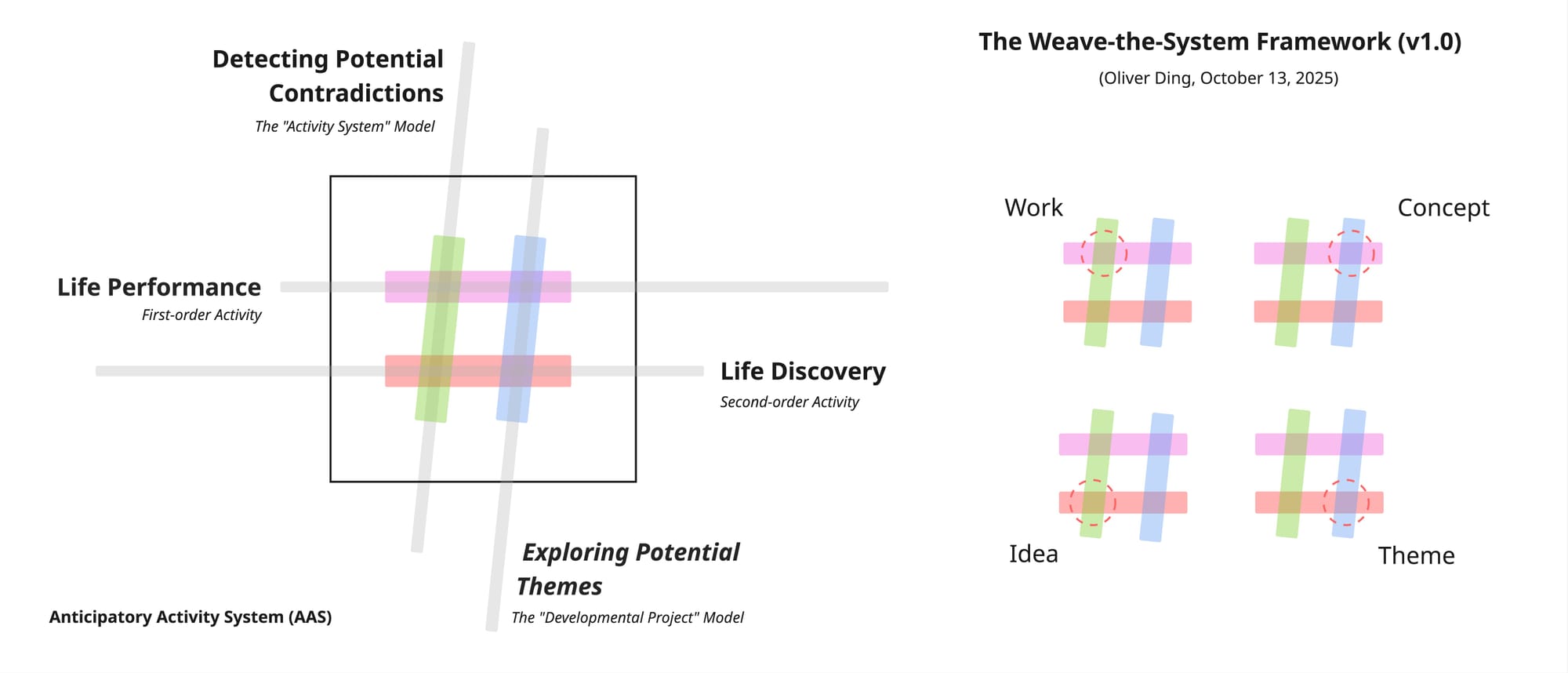
In the diagram above, the two diachronic dimensions correspond to two key principles derived from the Activity System Model and the Project Engagement approach:
- Detecting Potential Contradictions: from the "Activity System" Model
- Exploring Potential Themes: from the "Developmental Project" Model
A central concept in Activity Theory is that of contradictions. Engeström employed this concept to articulate the notion of expansion, stating:
Within the structure of any specific productive activity, the contradiction is renewed as the clash between individual actions and the total activity system…The fundamental contradiction arises out of the division of labor…The two directions or ‘opposite starting points’, from within an activity and from between two activities, are essential for the emerging concept of expansion… (1987, pp.98-99)
The concept of contradictions can be applied across multiple levels of analysis. For instance, it can describe contradictions within a single activity or between two activities. It may also be used to analyze both high-level, abstract “human activity systems”—such as subject-producing activity—and concrete, everyday activities, such as school bus activity.

Engeström used the above diagram to discuss four levels of contradictions within the human activity system at the abstract high level.
The concept of Theme is a central element of the Developmental Project Model. It was originally inspired by my earlier work on the Themes of Practice approach.
I understand Themes of Practice as a process-oriented concept rather than a substance-oriented concept. Instead of introducing a new category of themes, it emphasizes the transformational process that connects individual life themes with collective cultural themes. This concept integrates both conceptual understanding and practical action, linking mind and practice, while underscoring the transformation of both individuals and society.
In 2021, while developing Project-oriented Activity Theory, I identified a close connection between the notion of Themes of Practice and Andy Blunden’s concept of the Formation of Concept.

Blunden’s argument on the Concept resonates with my understanding of the Theme. Since a Theme can be regarded as a particular type of Concept, I adopt Blunden’s Hegel–Marx–Vygotsky account of Concept as the theoretical foundation for the Themes of Practice approach.
This theoretical foundation establishes a connection between the Developmental Project Model and the Creative Thematic Curation framework.

More details can be found in The Creative Thematic Curation Framework.
The two synchronic dimensions of the Weave-the-System Framework refer to Life Performance and Life Discovery, representing two types of activities within the Anticipatory Activity System (AAS) Framework:
- First-order Activity: Life Performance
- Second-order Activity: Life Discovery

Traditional Activity Theory views activity as object-oriented, which corresponds to First-order Activity in the Anticipatory Activity System (AAS) Framework. In this context, an activity is guided by a goal or objective, which in turn directs the initiation of a new activity.
However, questions arise: Where does the objective or goal originate? What happens when a person does not have a clear objective or goal?
In such situations, Second-order Activity emerges. Its purpose is to discover a suitable objective or goal for a subsequent activity—that is, for a First-order Activity.

More details can be found in A Typology for Anticipatory Activity System.
The Weave-the-System Framework also emphasizes four key knowledge elements located at the four Weave-points:
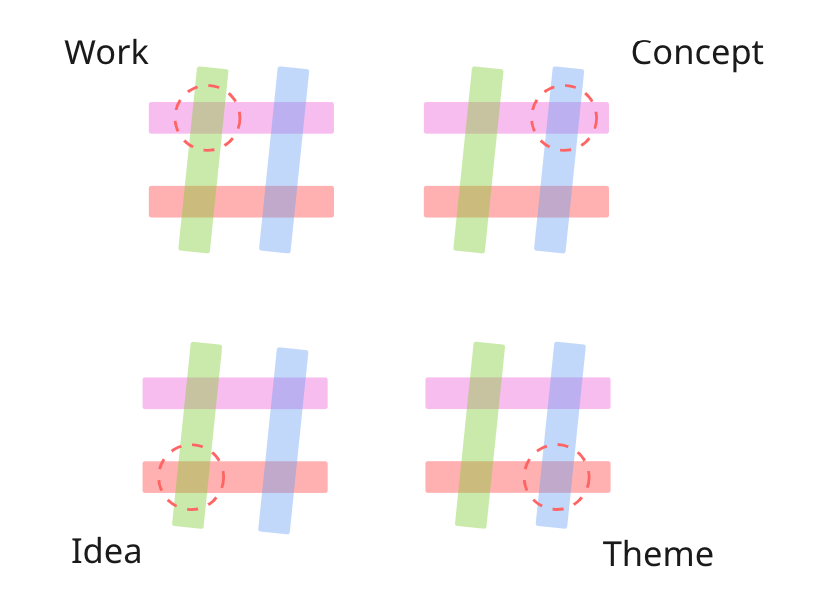
- Detecting Potential Contradictions × First-order Activity = Work
- Detecting Potential Contradictions × Second-order Activity = Idea
- Exploring Potential Themes × First-order Activity = Concept
- Exploring Potential Themes × Second-order Activity = Theme
By curating these key knowledge elements, the Weave-the-System Framework provides a simple diagram that helps to visualize the complexity of human activity.
The Weavr-the-Project Framework
The Project Engagement Approach is a project-centered social theory inspired by Andy Blunden's notion of the "project as a unit of analysis of activity." It aims to establish the concept of the "Project" as a theoretical foundation for cross-disciplinary research, creative dialogue, and deep reflection.
In May 2024, I developed version 3.1 of the Project Engagement approach. While version 1.0 focused on the Developmental Project Model, version 3.0 expanded this by curating a range of knowledge frameworks to explore project-oriented social ecology.
A key concept introduced in version 3.1 is the Social Landscape. It first emerged as an operational concept for designing the House of Project Engagement, serving as a map for narrative and reflection.

Over time, the concept evolved into a theoretical construct referring to the social environments and settings in which project-related activities take place.
Furthermore, the House of Project Engagement inspired the design of a series of thematic maps and knowledge maps, as well as the development of the “Map – Move – Model – Method – Meaning” schema and its associated methodology.
Ultimately, the concept of Thematic Space became a significant element within the Project Engagement Approach.
On March 18, 2205, I worked on a Knowledge Engagement project and introduced a new multi-layered thematic map, designed to structure different layers of knowledge engagement.

In the diagram above, I highlighted three layers:
- Layer 1: Thematic Spaces
- Layer 2: Project Engagement
- Layer 3: Social Landscape
Since the Knowledge Engagement project is an application of the Project Engagement Approach, this three-layer structure naturally reflects on the approach itself.
The Weave-the-Project Framework integrates these three concepts seamlessly (see the diagram below).
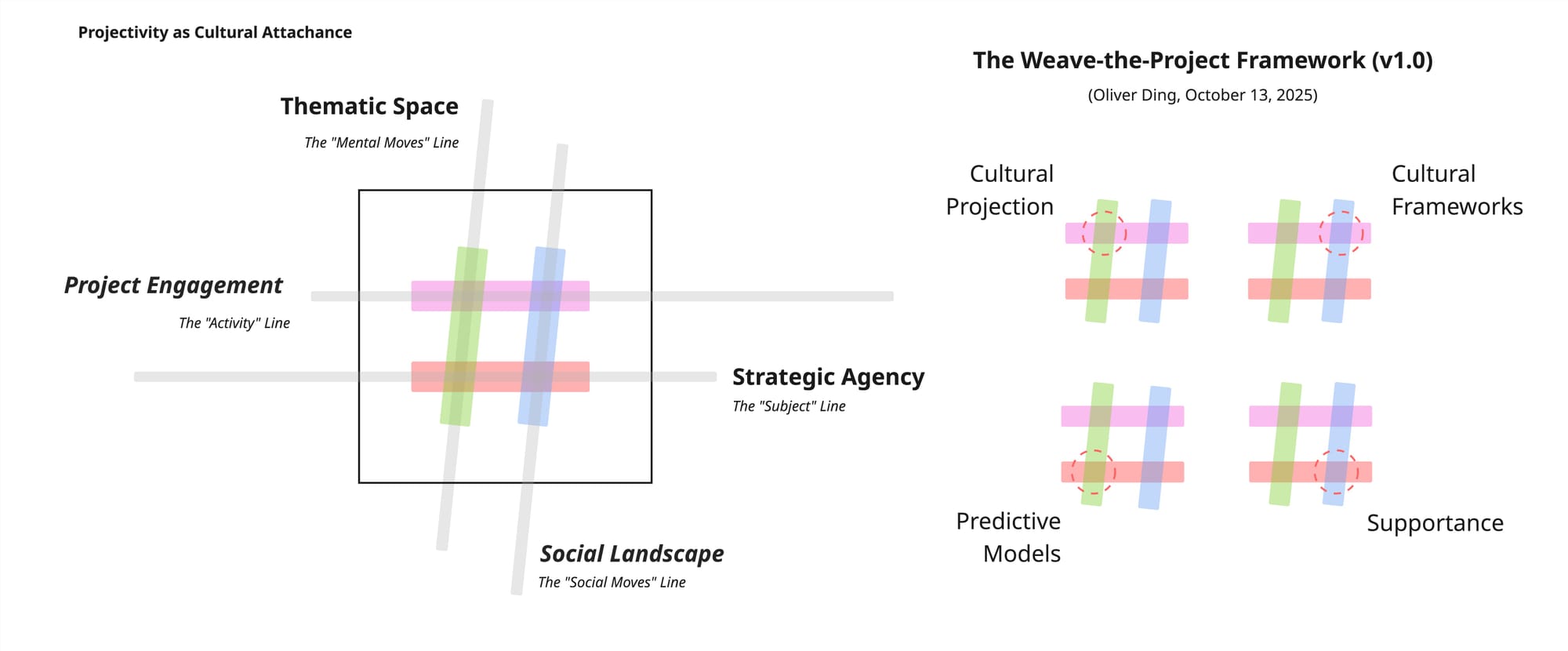
In the diagram above, the concepts of "Thematic Space" and "Social Landscape" serve as the two synchronic dimensions, while the two diachronic dimensions correspond to Project Engagement and Strategic Agency.
The four Weave-points represent the following four concepts:
- Thematic Space × Project Engagement = Cultural Projection
- Thematic Space × Strategic Agency = Predictive Models
- Social Landscape × Project Engagement = Cultural Frameworks
- Social Landscape × Strategic Agency = Supportance
Four of my book drafts are related to this framework:
- Mental Moves
- Social Moves
- Strategic Moves
- Frame for Work
For a detailed discussion of the concept of Supportance, see Supportance can be found in Supportance-based Life Development.
The Weave-the-Case Framework
The Weave Basic Form functions as a meta-framework. It can be used to curate knowledge elements and develop new frameworks for situational research and reflection.
The diagram below provides an example of such Situational Models.
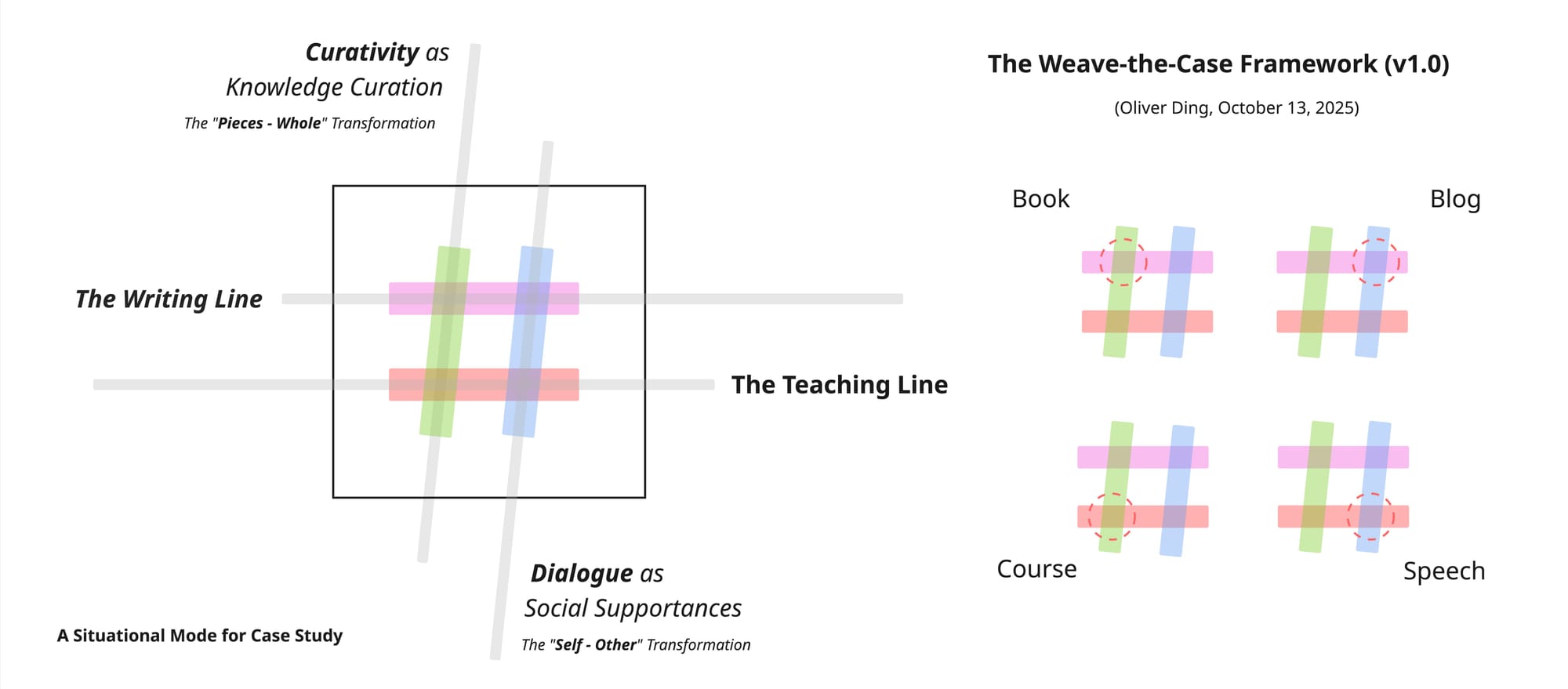
I used the diagram to reflect on a friend's creative life.
The friend is an academic who works at a university; over the past twenty years, he has published several books that have established a creative theme which I call Social Science Frame Dialogue. He worked with three theoretical traditions and applied the creative dialogue technique among these approaches to his projects.
On the public side, he hosted a blog for 20 years, where he regularly shared his book reviews and research ideas. He was also invited to give speeches at relevant events.
I selected two lines of the creative journey as two diachronic dimensions:
- The Writing Line
- The Teaching Line
The two synchronic dimensions were identified as follows;
- Curativity as Knowledge Curation (the Pieces — Whole transformation)
- Dialogue as Social Supportances (the Self — Other Transformation)
The term Curativity comes from Curativity Theory, while the term Supportance comes from Supportance Theory. Both theories are members of the Ecological Practice Approach.
Four weave-points are identified as Book, Blog, Course, and Speech.
Each weave-point represents a concrete expression of the creative life. The Book reflects the development of ideas and theoretical contributions; the Blog captures ongoing reflections and public engagement; the Course embodies structured teaching and knowledge transmission; and the Speech highlights interactive dialogue with broader communities. Together, these weave-points illustrate how the “Social Science Frame Dialogue” theme weaves individual creative activity with social and scholarly interactions. For further details on this theme, see TALE: The Theme of “Social Science Frame Dialogue.”
This example demonstrates the potential of the “Weave” model for application across diverse contexts. By customizing the four dimensions and four Weave-points, the situational framework can be used to curate relevant knowledge frameworks as resources for research or reflection.
Connect the Chain, Weave the Life
As discussed above, the Weave-the-Life Framework bridges Activity as Project Engagement and Life-History Topology, illustrating how the former unfolds into the latter.
Activity as Project Engagement serves as the fundamental ontology of the Life-as-Activity Approach, while the other two components expand this perspective into an extended ontology, viewing life as a project chain and history as a chain of events.

To establish this extended ontology, I employed “synchronic mapping” to describe the immediate Event–Project correspondence, and “diachronic unfolding” to capture the development of a chain of Projects and a chain of Events.
While Life emerges from the diachronic unfolding of the chain of projects, History emerges from the diachronic unfolding of the chain of events.
The Life-History Topology provides a model for understanding these processes at the macro level.

This model was inspired by the Project Engagement approach and the Themes of Practice approach. The pair of concepts “Event – Project” belongs to the Project Engagement approach, while the pair “Life Themes – Cultural Themes” comes from the Themes of Practice framework.
Andy Blunden notes that a project-oriented approach belongs to both psychology and sociology:
A project is a focus for an individual’s motivation, the indispensable vehicle for the exercise of their will and thus the key determinant of their psychology and the process which produces and reproduces the social fabric. Projects, therefore, give direct expression to the identity of the sciences of the mind and the social sciences. Projects belong to both; a project is a concept of both psychology and sociology. (2014, p.15)
In this light, the concept of Life can be understood as both Collective Life and Individual Life. The concept of Project provides a way to make sense of both. A person’s real life is a set of concrete actions, and the notion of Project offers a way to curate and integrate these actions. Likewise, Collective Life can also be curated through projects.
Life can be seen as the diachronic unfolding of a chain of projects, just as history can be seen as the diachronic unfolding of a chain of events.
While Life is a chain of projects, it can also be understood as a journey of moving between various thematic spaces. Each project has primary themes as well as secondary themes. By joining and leaving projects, we enact our significant Life Themes. In this sense, projects themselves can also be understood as Thematic Spaces.
Life = Projects = Thematic Spaces = Events = History
In this way, the Life-as-Activity Approach echoes Andy Blunden’s idea that “a project is a concept of both psychology and sociology” (2014, p. 15). Here, the notion of Engagement takes on a new meaning: it refers to moving between Thematic Spaces.
More details can be found in Project Engagement (v2): Life, History, and Multiverse.
The Life-History Topology was introduced in 2022; however, the details of unfolding the chain had not yet been fully explored.
The Weave-the-Life Framework now employs two synchronic dimensions and two diachronic dimensions to map “Activity as Project Engagement” onto the Life-History Topology, clarifying the previously missing details.
Although the framework currently presents only three diagrams, its underlying method, together with the Weave Basic Form, provides an open yet systematic approach for exploring Life as Activity.
V1 - October 14, 2025 - 2943 words
